Progesterone Signaling and Mammalian Ovarian Follicle Growth Mediated by Progesterone Receptor Membrane Component Family Members
Abstract
1. Introduction
2. Search for an Alternative Progesterone Receptor in Granulosa Cells
2.1. Ovarian Expression of PAIRBP1 and PGRMC Family Members
2.1.1. Expression in Ovaries of Laboratory and Domestic Animals
2.1.2. Expression in the Healthy and Dysfunctional Human Ovary
3. PGRMC1 as a Mediator of Progesterone’s Actions
3.1. Capacity of PGRMC1 to Specifically Bind Progesterone
3.2. PGRMC Family Members and Their Roles in Regulating Granulosa Cell Function
3.2.1. Steroidogenesis
3.2.2. Mitosis and Apoptosis
3.2.3. Duration of Metaphase
4. PGRMC1 and Multiple Sites of Action
4.1. Actions Initiated at the Plasma Membrane
4.2. Actions Initiated within the Cytoplasm
4.3. Nuclear Site of Action
5. PGRMCs and Follicle Growth In Vivo
6. Summary and Future Research
- What factors trigger the cell-cycle-dependent expression of PGRMC2 that appears to allow for the controlled entry into the cell cycle?
- Do the interactions between PGRMC1, PGRMC2, PAQR7, and PGR result in a single complex or are there different combinations that occur at specific cellular sites and are these complexes linked to specific signal transduction pathways that are regulated by the hormonal environment?
- How do the numerous potential post-translation modifications such as changes in sumoylation and phosphorylation affect PGRMC1′s cellular localization and interaction with specific proteins that ultimately accounts for progesterone’s actions?
- Are there multiple mechanisms by which PGRMC modulates gene expression? If so, can these mechanisms be individually manipulated to either enhance or inhibit progesterone’s actions without influencing PGR’s role in ovarian function?
- How are changes in the expression and sumoylation and phosphorylation status of PGRMC1 and PGRMC2 related to the dysfunction of the human ovary such as premature ovarian insufficiency and polycystic ovarian syndrome?
- How does the expression profile of these progesterone receptors change or modulate progesterone’s ability to transduce its anti-mitotic and anti-apoptotic action and does the patient-specific profile affect the outcome of fertility treatment?
Funding
Institutional Review Board Statement
Informed Consent Statement
Data Availability Statement
Acknowledgments
Conflicts of Interest
Abbreviations
| PGR | Nuclear Progesterone Receptor |
| PAQR | Progestin and AdipoQ Receptor |
| PGRMC | Progesterone Membrane Receptor Component family |
| SIGCs | Spontaneously Immortalized Granulosa Cells |
| PAIRBP1 | Plasminogen Activator Inhibitor 1 RNA-binding protein |
| SERBP1 | Serpine mRNA Binding Protein 1 |
| IVF | In Vitro Fertilization |
| PCOS | Polycystic Ovary Syndrome |
| H165R | A missense point mutation where histidine (H) at amino acid 165 is changed to an arginine (R) |
| TCF/Lef1 | Ternary Complex Factors/Lymphoid enhancer factor 1 |
| G3BP2 | GTPase-activating protein-binding protein 2 |
| NFκB/p65 | Nuclear Factor Kappa B |
| IκBα | NFκB inhibitor alpha |
| VEGFA | Vascular Endothelial Growth Factor A |
| EGF | Epidermal growth factor |
| BrdU | Bromodeoxyuridine/5-bromo-2’-deoxyuridine |
| AP-1 | Activating protein 1 |
| PI3K | Phosphoinositide 3-kinase |
| PKB | Protein kinase B (PKB; as known as AKT) |
| MAPK | Mitogen-activated protein kinase |
References
- Rothchild, I. The regulation of the mammalian corpus luteum. Recent Prog. Horm. Res. 1981, 37, 183–298. [Google Scholar] [CrossRef]
- Rothchild, I. The corpus luteum revisited: Are the paradoxical effects of RU486 a clue to how progesterone stimulates its own secretion? Biol. Reprod. 1996, 55, 1–4. [Google Scholar] [CrossRef] [PubMed]
- Moore, P.J.; Greenwald, G.S. Effect of hypophysectomy and gonadotropin treatment on follicular development and ovulation in the hamster. Am. J. Anat. 1974, 139, 37–48. [Google Scholar] [CrossRef] [PubMed]
- Kim, I.; Greenwald, G.S. Stimulatory and inhibitory effects of progesterone on follicular development in the hypophysectomized follicle-stimulating hormone/luteinizing hormone-treated hamster. Biol. Reprod. 1987, 36, 270–276. [Google Scholar] [CrossRef] [PubMed]
- Buffler, G.; Roser, S. New data concerning the role played by progesterone in the control of follicular growth in the rat. Eur. J. Endocrinol. 1974, 75, 569–578. [Google Scholar] [CrossRef] [PubMed]
- Peluso, J.J.; Leiper, S.; Steger, R.W. Effects of PGF2 alpha-induced luteolysis and progesterone on follicular growth in pregnant mice. Prostaglandins 1980, 19, 437–447. [Google Scholar] [CrossRef]
- diZerega, G.S.; Hodgen, G.D. The interovarian progesterone gradient: A spatial and temporal regulator of folliculogenesis in the primate ovarian cycle. J. Clin. Endocrinol. Metab. 1982, 54, 495–499. [Google Scholar] [CrossRef]
- Luciano, A.M.; Pappalardo, A.; Ray, C.; Peluso, J.J. Epidermal growth factor inhibits large granulosa cell apoptosis by stimulating progesterone synthesis and regulating the distribution of intracellular free calcium. Biol. Reprod. 1994, 51, 646–654. [Google Scholar] [CrossRef]
- Luciano, A.M.; Peluso, J.J. Effect of in vivo gonadotropin treatment on the ability of progesterone, estrogen, and cyclic adenosine 5’-monophosphate to inhibit insulin-dependent granulosa cell mitosis in vitro. Biol. Reprod. 1995, 53, 664–669. [Google Scholar] [CrossRef][Green Version]
- Peluso, J.J.; Pappalardo, A. Progesterone and cell–cell adhesion interact to regulate rat granulosa cell apoptosis. Biochem. Cell Biol. 1994, 72, 547–551. [Google Scholar] [CrossRef]
- Chaffkin, L.M.; Luciano, A.A.; Peluso, J.J. Progesterone as an autocrine/paracrine regulator of human granulosa cell proliferation. J. Clin. Endocrinol. Metab. 1992, 75, 1404–1408. [Google Scholar] [CrossRef] [PubMed]
- Chaffkin, L.M.; Luciano, A.A.; Peluso, J.J. The role of progesterone in regulating human granulosa cell proliferation and differentiation in vitro. J. Clin. Endocrinol. Metab. 1993, 76, 696–700. [Google Scholar] [CrossRef] [PubMed]
- Schreiber, J.R.; Erickson, G.F. Progesterone receptor in the rat ovary: Further characterization and localization in the granulosa cell. Steroids 1979, 34, 459–469. [Google Scholar] [CrossRef]
- Schreiber, J.R.; Hsueh, J.W. Progesterone “receptor” in rat ovary. Endocrinology 1979, 105, 915–919. [Google Scholar] [CrossRef]
- O’Malley, B.W.; Sherman, M.R.; Toft, D.O. Progesterone “receptors” in the cytoplasm and nucleus of chick oviduct target tissue. Proc. Natl. Acad. Sci. USA 1970, 67, 501–508. [Google Scholar] [CrossRef]
- Sherman, M.R.; Corvol, P.L.; O’Malley, B.W. Progesterone-binding components of chick oviduct. I. Preliminary characterization of cytoplasmic components. J. Biol. Chem. 1970, 245, 6085–6096. [Google Scholar] [CrossRef]
- Mester, J.; Baulieu, E.E. Progesterone receptors in the chick oviduct. Determination of the total concentration of binding sites in the cytosol and nuclear fraction and effect of progesterone on their distribution. Eur. J. Biochem. 1977, 72, 405–414. [Google Scholar] [CrossRef]
- Mulvihill, E.R.; LePennec, J.P.; Chambon, P. Chicken oviduct progesterone receptor: Location of specific regions of high-affinity binding in cloned DNA fragments of hormone-responsive genes. Cell 1982, 28, 621–632. [Google Scholar] [CrossRef]
- Conneely, O.M.; Sullivan, W.P.; Toft, D.O.; Birnbaumer, M.; Cook, R.G.; Maxwell, B.L.; Zarucki-Schulz, T.; Greene, G.L.; Schrader, W.T.; O’Malley, B.W. Molecular cloning of the chicken progesterone receptor. Science 1986, 233, 767–770. [Google Scholar] [CrossRef]
- Jeltsch, J.M.; Krozowski, Z.; Quirin-Stricker, C.; Gronemeyer, H.; Simpson, R.J.; Garnier, J.M.; Krust, A.; Jacob, F.; Chambon, P. Cloning of the chicken progesterone receptor. Proc. Natl. Acad. Sci. USA 1986, 83, 5424–5428. [Google Scholar] [CrossRef]
- Natraj, U.; Richards, J.S. Hormonal regulation, localization, and functional activity of the progesterone receptor in granulosa cells of rat preovulatory follicles. Endocrinology 1993, 133, 761–769. [Google Scholar] [CrossRef] [PubMed]
- Park, C.J.; Lin, P.C.; Zhou, S.; Barakat, R.; Bashir, S.T.; Choi, J.M.; Cacioppo, J.A.; Oakley, O.R.; Duffy, D.M.; Lydon, J.P.; et al. Progesterone Receptor Serves the Ovary as a Trigger of Ovulation and a Terminator of Inflammation. Cell Rep. 2020, 31, 107496. [Google Scholar] [CrossRef] [PubMed]
- Park, O.K.; Mayo, K.E. Transient expression of progesterone receptor messenger RNA in ovarian granulosa cells after the preovulatory luteinizing hormone surge. Mol. Endocrinol. 1991, 5, 967–978. [Google Scholar] [CrossRef] [PubMed][Green Version]
- Park-Sarge, O.K.; Mayo, K.E. Regulation of the progesterone receptor gene by gonadotropins and cyclic adenosine 3′,5′-monophosphate in rat granulosa cells. Endocrinology 1994, 134, 709–718. [Google Scholar] [CrossRef] [PubMed]
- Park-Sarge, O.K.; Parmer, T.G.; Gu, Y.; Gibori, G. Does the rat corpus luteum express the progesterone receptor gene? Endocrinology 1995, 136, 1537–1543. [Google Scholar] [CrossRef]
- Stein, L.S.; Stoica, G.; Tilley, R.; Burghardt, R.C. Rat ovarian granulosa cell culture: A model system for the study of cell-cell communication during multistep transformation. Cancer Res. 1991, 51, 696–706. [Google Scholar]
- Peluso, J.J.; Fernandez, G.; Pappalardo, A.; White, B.A. Characterization of a putative membrane receptor for progesterone in rat granulosa cells. Biol. Reprod. 2001, 65, 94–101. [Google Scholar] [CrossRef]
- Leonhardt, S.A.; Boonyaratanakornkit, V.; Edwards, D.P. Progesterone receptor transcription and non-transcription signaling mechanisms. Steroids 2003, 68, 761–770. [Google Scholar] [CrossRef]
- Peluso, J.J.; Pappalardo, A. Progesterone mediates its anti-mitogenic and anti-apoptotic actions in rat granulosa cells through a progesterone-binding protein with gamma aminobutyric acidA receptor-like features. Biol. Reprod. 1998, 58, 1131–1137. [Google Scholar] [CrossRef]
- Peluso, J.J. Rapid actions of progesterone on granulosa cells. Steroids 2004, 69, 579–583. [Google Scholar] [CrossRef]
- Peluso, J.J.; Pappalardo, A.; Fernandez, G.; Wu, C.A. Involvement of an unnamed protein, RDA288, in the mechanism through which progesterone mediates its antiapoptotic action in spontaneously immortalized granulosa cells. Endocrinology 2004, 145, 3014–3022. [Google Scholar] [CrossRef] [PubMed][Green Version]
- Peluso, J.J.; Pappalardo, A.; Losel, R.; Wehling, M. Expression and function of PAIRBP1 within gonadotropin-primed immature rat ovaries: PAIRBP1 regulation of granulosa and luteal cell viability. Biol. Reprod. 2005, 73, 261–270. [Google Scholar] [CrossRef] [PubMed]
- Meyer, C.; Christ, M.; Wehling, M. Characterization and solubilization of novel aldosterone-binding proteins in porcine liver microsomes. Eur. J. Biochem. 1995, 229, 736–740. [Google Scholar] [CrossRef] [PubMed]
- Meyer, C.; Schmid, R.; Scriba, P.C.; Wehling, M. Purification and partial sequencing of high-affinity progesterone-binding site(s) from porcine liver membranes. Eur. J. Biochem. 1996, 239, 726–731. [Google Scholar] [CrossRef] [PubMed]
- Gerdes, D.; Wehling, M.; Leube, B.; Falkenstein, E. Cloning and tissue expression of two putative steroid membrane receptors. Biol. Chem. 1998, 379, 907–911. [Google Scholar] [CrossRef] [PubMed]
- Peluso, J.J.; Pappalardo, A.; Losel, R.; Wehling, M. Progesterone membrane receptor component 1 expression in the immature rat ovary and its role in mediating progesterone’s antiapoptotic action. Endocrinology 2006, 147, 3133–3140. [Google Scholar] [CrossRef][Green Version]
- Hirshfield, A.N. Stathmokinetic analysis of granulosa cell proliferation in antral follicles of cyclic rats. Biol. Reprod. 1984, 31, 52–58. [Google Scholar] [CrossRef]
- McCallum, M.L.; Pru, C.A.; Niikura, Y.; Yee, S.P.; Lydon, J.P.; Peluso, J.J.; Pru, J.K. Conditional Ablation of Progesterone Receptor Membrane Component 1 Results in Subfertility in the Female and Development of Endometrial Cysts. Endocrinology 2016, 157, 3309–3319. [Google Scholar] [CrossRef]
- Griffin, D.; Liu, X.; Pru, C.; Pru, J.K.; Peluso, J.J. Expression of progesterone receptor membrane component-2 within the immature rat ovary and its role in regulating mitosis and apoptosis of spontaneously immortalized granulosa cells. Biol. Reprod. 2014, 91, 36. [Google Scholar] [CrossRef]
- Clark, N.C.; Pru, C.A.; Yee, S.P.; Lydon, J.P.; Peluso, J.J.; Pru, J.K. Conditional Ablation of Progesterone Receptor Membrane Component 2 Causes Female Premature Reproductive Senescence. Endocrinology 2017, 158, 640–651. [Google Scholar] [CrossRef]
- Blaschka, C.; Sanchez-Guijo, A.; Zimmer, B.; Stohr, J.; Kotarski, F.; Grothmann, H.; Hartmann, M.F.; Wudy, S.A.; Wrenzycki, C. Temporal expression pattern of steroid-metabolizing enzymes in bovine COC during in vitro maturation employing different gonadotropin concentrations. Theriogenology 2019, 131, 182–192. [Google Scholar] [CrossRef] [PubMed]
- Ciesiolka, S.; Budna, J.; Jopek, K.; Bryja, A.; Kranc, W.; Chachula, A.; Borys, S.; Dyszkiewicz Konwinska, M.; Ziolkowska, A.; Antosik, P.; et al. Influence of Estradiol-17beta on Progesterone and Estrogen Receptor mRNA Expression in Porcine Follicular Granulosa Cells during Short-Term, In Vitro Real-Time Cell Proliferation. BioMed Res. Int. 2016, 2016, 8431018. [Google Scholar] [CrossRef] [PubMed]
- Luciano, A.M.; Corbani, D.; Lodde, V.; Tessaro, I.; Franciosi, F.; Peluso, J.J.; Modina, S. Expression of progesterone receptor membrane component-1 in bovine reproductive system during estrous cycle. Eur. J. Histochem. 2011, 55, e27. [Google Scholar] [CrossRef] [PubMed]
- Kaczynski, P.; Baryla, M.; Goryszewska, E.; Waclawik, A. Estradiol-17beta Regulates Expression of Luteal DNA Methyltransferases and Genes Involved in the Porcine Corpus Luteum Function In Vivo. Int. J. Mol. Sci. 2021, 22, 3655. [Google Scholar] [CrossRef] [PubMed]
- Przygrodzka, E.; Kaczmarek, M.M.; Kaczynski, P.; Ziecik, A.J. Steroid hormones, prostanoids, and angiogenic systems during rescue of the corpus luteum in pigs. Reproduction 2016, 151, 135–147. [Google Scholar] [CrossRef] [PubMed]
- Kowalik, M.K.; Dobrzyn, K.; Mlynarczuk, J.; Rekawiecki, R. Effect of Steroid Hormones, Prostaglandins (E2 and F2alpha), Oxytocin, and Tumor Necrosis Factor Alpha on Membrane Progesterone (P4) Receptors Gene Expression in Bovine Myometrial Cells. Animals 2022, 12, 519. [Google Scholar] [CrossRef] [PubMed]
- Kowalik, M.K.; Martyniak, M.; Rekawiecki, R.; Kotwica, J. Expression and immunolocalization of membrane progesterone receptors in the bovine oviduct. Domest. Anim. Endocrinol. 2016, 55, 83–96. [Google Scholar] [CrossRef]
- Kowalik, M.K.; Rekawiecki, R.; Kotwica, J. Expression and localization of progesterone receptor membrane component 1 and 2 and serpine mRNA binding protein 1 in the bovine corpus luteum during the estrous cycle and the first trimester of pregnancy. Theriogenology 2014, 82, 1086–1093. [Google Scholar] [CrossRef]
- Amelkina, O.; Zschockelt, L.; Painer, J.; Serra, R.; Villaespesa, F.; Krause, E.; Jewgenow, K.; Braun, B.C. Progesterone, estrogen, and androgen receptors in the corpus luteum of the domestic cat, Iberian lynx (Lynx pardinus) and Eurasian lynx (Lynx lynx). Theriogenology 2016, 86, 2107–2118. [Google Scholar] [CrossRef]
- Bishop, C.V.; Satterwhite, S.; Xu, L.; Hennebold, J.D.; Stouffer, R.L. Microarray analysis of the primate luteal transcriptome during chorionic gonadotrophin administration simulating early pregnancy. Mol. Hum. Reprod. 2012, 18, 216–227. [Google Scholar] [CrossRef]
- Engmann, L.; Losel, R.; Wehling, M.; Peluso, J.J. Progesterone regulation of human granulosa/luteal cell viability by an RU486-independent mechanism. J. Clin. Endocrinol. Metab. 2006, 91, 4962–4968. [Google Scholar] [CrossRef] [PubMed][Green Version]
- Elassar, A.; Liu, X.; Scranton, V.; Wu, C.A.; Peluso, J.J. The relationship between follicle development and progesterone receptor membrane component-1 expression in women undergoing in vitro fertilization. Fertil. Steril. 2012, 97, 572–578. [Google Scholar] [CrossRef] [PubMed]
- Mansouri, M.R.; Schuster, J.; Badhai, J.; Stattin, E.L.; Losel, R.; Wehling, M.; Carlsson, B.; Hovatta, O.; Karlstrom, P.O.; Golovleva, I.; et al. Alterations in the expression, structure and function of progesterone receptor membrane component-1 (PGRMC1) in premature ovarian failure. Hum. Mol. Genet. 2008, 17, 3776–3783. [Google Scholar] [CrossRef] [PubMed]
- Wang, J.L.; Li, S.L.; Qin, Y.Y.; Chen, Z.J. Analysis of progesterone receptor membrane component 1 mutation in Han Chinese women with premature ovarian failure. Reprod. Biomed. Online 2014, 29, 640–643. [Google Scholar] [CrossRef] [PubMed]
- Schuster, J.; Karlsson, T.; Karlstrom, P.O.; Poromaa, I.S.; Dahl, N. Down-regulation of progesterone receptor membrane component 1 (PGRMC1) in peripheral nucleated blood cells associated with premature ovarian failure (POF) and polycystic ovary syndrome (PCOS). Reprod. Biol. Endocrinol. 2010, 8, 58. [Google Scholar] [CrossRef]
- Vaitsopoulou, C.I.; Kolibianakis, E.M.; Bosdou, J.K.; Neofytou, E.; Lymperi, S.; Makedos, A.; Savvaidou, D.; Chatzimeletiou, K.; Grimbizis, G.F.; Lambropoulos, A.; et al. Expression of genes that regulate follicle development and maturation during ovarian stimulation in poor responders. Reprod. Biomed. Online 2021, 42, 248–259. [Google Scholar] [CrossRef]
- Peluso, J.J.; Romak, J.; Liu, X. Progesterone receptor membrane component-1 (PGRMC1) is the mediator of progesterone’s antiapoptotic action in spontaneously immortalized granulosa cells as revealed by PGRMC1 small interfering ribonucleic acid treatment and functional analysis of PGRMC1 mutations. Endocrinology 2008, 149, 534–543. [Google Scholar] [CrossRef]
- Peluso, J.J.; Yuan, A.; Liu, X.; Lodde, V. Plasminogen activator inhibitor 1 RNA-binding protein interacts with progesterone receptor membrane component 1 to regulate progesterone’s ability to maintain the viability of spontaneously immortalized granulosa cells and rat granulosa cells. Biol. Reprod. 2013, 88, 20. [Google Scholar] [CrossRef][Green Version]
- Kaluka, D.; Batabyal, D.; Chiang, B.Y.; Poulos, T.L.; Yeh, S.R. Spectroscopic and mutagenesis studies of human PGRMC1. Biochemistry 2015, 54, 1638–1647. [Google Scholar] [CrossRef]
- Thomas, P.; Pang, Y.; Dong, J. Enhancement of cell surface expression and receptor functions of membrane progestin receptor alpha (mPRalpha) by progesterone receptor membrane component 1 (PGRMC1): Evidence for a role of PGRMC1 as an adaptor protein for steroid receptors. Endocrinology 2014, 155, 1107–1119. [Google Scholar] [CrossRef]
- Sueldo, C.; Liu, X.; Peluso, J.J. Progestin and AdipoQ Receptor 7, Progesterone Membrane Receptor Component 1 (PGRMC1), and PGRMC2 and Their Role in Regulating Progesterone’s Ability to Suppress Human Granulosa/Luteal Cells from Entering into the Cell Cycle. Biol. Reprod. 2015, 93, 63. [Google Scholar] [CrossRef] [PubMed]
- Peluso, J.J.; Liu, X.; Gawkowska, A.; Johnston-MacAnanny, E. Progesterone activates a progesterone receptor membrane component 1-dependent mechanism that promotes human granulosa/luteal cell survival but not progesterone secretion. J. Clin. Endocrinol. Metab. 2009, 94, 2644–2649. [Google Scholar] [CrossRef] [PubMed]
- Ryu, C.S.; Klein, K.; Zanger, U.M. Membrane Associated Progesterone Receptors: Promiscuous Proteins with Pleiotropic Functions—Focus on Interactions with Cytochromes P450. Front. Pharmacol. 2017, 8, 159. [Google Scholar] [CrossRef] [PubMed]
- Hughes, A.L.; Powell, D.W.; Bard, M.; Eckstein, J.; Barbuch, R.; Link, A.J.; Espenshade, P.J. Dap1/PGRMC1 binds and regulates cytochrome P450 enzymes. Cell Metab. 2007, 5, 143–149. [Google Scholar] [CrossRef]
- Hurd, C.; Moudgil, V.K. Characterization of R5020 and RU486 binding to progesterone receptor from calf uterus. Biochemistry 1988, 27, 3618–3623. [Google Scholar] [CrossRef]
- Dressing, G.E.; Alyea, R.; Pang, Y.; Thomas, P. Membrane progesterone receptors (mPRs) mediate progestin induced antimorbidity in breast cancer cells and are expressed in human breast tumors. Horm. Cancer 2012, 3, 101–112. [Google Scholar] [CrossRef]
- McGuire, M.R.; Mukhopadhyay, D.; Myers, S.L.; Mosher, E.P.; Brookheart, R.T.; Kammers, K.; Sehgal, A.; Selen, E.S.; Wolfgang, M.J.; Bumpus, N.N.; et al. Progesterone receptor membrane component 1 (PGRMC1) binds and stabilizes cytochromes P450 through a heme-independent mechanism. J. Biol. Chem. 2021, 297, 101316. [Google Scholar] [CrossRef]
- Lee, S.R.; Kwon, S.W.; Kaya, P.; Lee, Y.H.; Lee, J.G.; Kim, G.; Lee, G.S.; Baek, I.J.; Hong, E.J. Loss of progesterone receptor membrane component 1 promotes hepatic steatosis via the induced de novo lipogenesis. Sci. Rep. 2018, 8, 15711. [Google Scholar] [CrossRef]
- Hu, J.; Zhang, Z.; Shen, W.J.; Azhar, S. Cellular cholesterol delivery, intracellular processing and utilization for biosynthesis of steroid hormones. Nutr. Metab. 2010, 7, 47. [Google Scholar] [CrossRef]
- Lederer, K.J.; Luciano, A.M.; Pappalardo, A.; Peluso, J.J. Proliferative and steroidogenic capabilities of rat granulosa cells of different sizes. J. Reprod. Fertil. 1995, 103, 47–54. [Google Scholar] [CrossRef]
- Peluso, J.J.; Griffin, D.; Liu, X.; Horne, M. Progesterone receptor membrane component-1 (PGRMC1) and PGRMC-2 interact to suppress entry into the cell cycle in spontaneously immortalized rat granulosa cells. Biol. Reprod. 2014, 91, 104. [Google Scholar] [CrossRef] [PubMed]
- Terzaghi, L.; Tessaro, I.; Raucci, F.; Merico, V.; Mazzini, G.; Garagna, S.; Zuccotti, M.; Franciosi, F.; Lodde, V. PGRMC1 participates in late events of bovine granulosa cells mitosis and oocyte meiosis. Cell Cycle 2016, 15, 2019–2032. [Google Scholar] [CrossRef] [PubMed][Green Version]
- Lodde, V.; Peluso, J.J. A novel role for progesterone and progesterone receptor membrane component 1 in regulating spindle microtubule stability during rat and human ovarian cell mitosis. Biol. Reprod. 2011, 84, 715–722. [Google Scholar] [CrossRef] [PubMed]
- Will, E.A.; Peluso, J. Progesterone atteuates oxidative stress induced and FAS lignand mediated apoptosis of human granulosa/luteal cell by different mechanisms (Abstract). Fertil. Steril. 2017, 108, e318. [Google Scholar] [CrossRef][Green Version]
- Will, E.A.; Liu, X.; Peluso, J.J. AG 205, a progesterone receptor membrane component 1 antagonist, ablates progesterone’s ability to block oxidative stress-induced apoptosis of human granulosa/luteal cellsdagger. Biol. Reprod. 2017, 96, 843–854. [Google Scholar] [CrossRef]
- Peluso, J.J.; DeCerbo, J.; Lodde, V. Evidence for a genomic mechanism of action for progesterone receptor membrane component-1. Steroids 2012, 77, 1007–1012. [Google Scholar] [CrossRef]
- Peluso, J.J.; Lodde, V.; Liu, X. Progesterone regulation of progesterone receptor membrane component 1 (PGRMC1) sumoylation and transcriptional activity in spontaneously immortalized granulosa cells. Endocrinology 2012, 153, 3929–3939. [Google Scholar] [CrossRef]
- Kabe, Y.; Nakane, T.; Koike, I.; Yamamoto, T.; Sugiura, Y.; Harada, E.; Sugase, K.; Shimamura, T.; Ohmura, M.; Muraoka, K.; et al. Haem-dependent dimerization of PGRMC1/Sigma-2 receptor facilitates cancer proliferation and chemoresistance. Nat. Commun. 2016, 7, 11030. [Google Scholar] [CrossRef]
- Peluso, J.J. Progesterone as a regulator of granulosa cell viability. J. Steroid Biochem. Mol. Biol. 2003, 85, 167–173. [Google Scholar] [CrossRef]
- Peluso, J.J.; Liu, X.; Romak, J. Progesterone maintains basal intracellular adenosine triphosphate levels and viability of spontaneously immortalized granulosa cells by promoting an interaction between 14-3-3sigma and ATP synthase beta/precursor through a protein kinase G-dependent mechanism. Endocrinology 2007, 148, 2037–2044. [Google Scholar] [CrossRef]
- Peluso, J.J.; Pappalardo, A. Progesterone regulates granulosa cell viability through a protein kinase G-dependent mechanism that may involve 14-3-3sigma. Biol. Reprod. 2004, 71, 1870–1878. [Google Scholar] [CrossRef] [PubMed]
- Hampton, K.K.; Anderson, K.; Frazier, H.; Thibault, O.; Craven, R.J. Insulin Receptor Plasma Membrane Levels Increased by the Progesterone Receptor Membrane Component 1. Mol. Pharmacol. 2018, 94, 665–673. [Google Scholar] [CrossRef] [PubMed]
- Ahmed, I.S.; Rohe, H.J.; Twist, K.E.; Craven, R.J. Pgrmc1 (progesterone receptor membrane component 1) associates with epidermal growth factor receptor and regulates erlotinib sensitivity. J. Biol. Chem. 2010, 285, 24775–24782. [Google Scholar] [CrossRef] [PubMed]
- Bodart, J.F. Extracellular-regulated kinase-mitogen-activated protein kinase cascade: Unsolved issues. J. Cell. Biochem. 2010, 109, 850–857. [Google Scholar] [CrossRef] [PubMed]
- Dalhausser, A.K.; Rossler, O.G.; Thiel, G. Regulation of c-Fos gene transcription by stimulus-responsive protein kinases. Gene 2022, 821, 146284. [Google Scholar] [CrossRef]
- Peluso, J.J.; Bremner, T.; Fernandez, G.; Pappalardo, A.; White, B.A. Expression pattern and role of a 60-kilodalton progesterone binding protein in regulating granulosa cell apoptosis: Involvement of the mitogen-activated protein kinase cascade. Biol. Reprod. 2003, 68, 122–128. [Google Scholar] [CrossRef]
- Peluso, J.J.; Pru, C.A.; Liu, X.; Kelp, N.C.; Pru, J.K. Progesterone receptor membrane component 1 and 2 regulate granulosa cell mitosis and survival through a NFKappaB-dependent mechanismdagger. Biol. Reprod. 2019, 100, 1571–1580. [Google Scholar] [CrossRef]
- Peluso, J.J.; Pru, J.K. Progesterone Receptor Membrane Component (PGRMC)1 and PGRMC2 and Their Roles in Ovarian and Endometrial Cancer. Cancers 2021, 13, 5953. [Google Scholar] [CrossRef]
- Mauro, V.P.; Edelman, G.M. The ribosome filter hypothesis. Proc. Natl. Acad. Sci. USA 2002, 99, 12031–12036. [Google Scholar] [CrossRef]
- Cahill, M.A. Progesterone receptor membrane component 1: An integrative review. J. Steroid Biochem. Mol. Biol. 2007, 105, 16–36. [Google Scholar] [CrossRef]
- Peluso, J.J. Progesterone receptor membrane component 1 and its role in ovarian follicle growth. Front. Neurosci. 2013, 7, 99. [Google Scholar] [CrossRef] [PubMed]
- Peluso, J.J.; Pru, J.K. Non-canonical progesterone signaling in granulosa cell function. Reproduction 2014, 147, R169–R178. [Google Scholar] [CrossRef] [PubMed]
- Peluso, J.J.; Liu, X.; Uliasz, T.; Pru, C.A.; Kelp, N.C.; Pru, J.K. PGRMC1/2 promotes luteal vascularization and maintains the primordial follicles of mice. Reproduction 2018, 156, 365–373. [Google Scholar] [CrossRef] [PubMed]
- Guo, M.; Zhang, C.; Wang, Y.; Feng, L.; Wang, Z.; Niu, W.; Du, X.; Tang, W.; Li, Y.; Wang, C.; et al. Progesterone Receptor Membrane Component 1 Mediates Progesterone-Induced Suppression of Oocyte Meiotic Prophase I and Primordial Folliculogenesis. Sci. Rep. 2016, 6, 36869. [Google Scholar] [CrossRef]
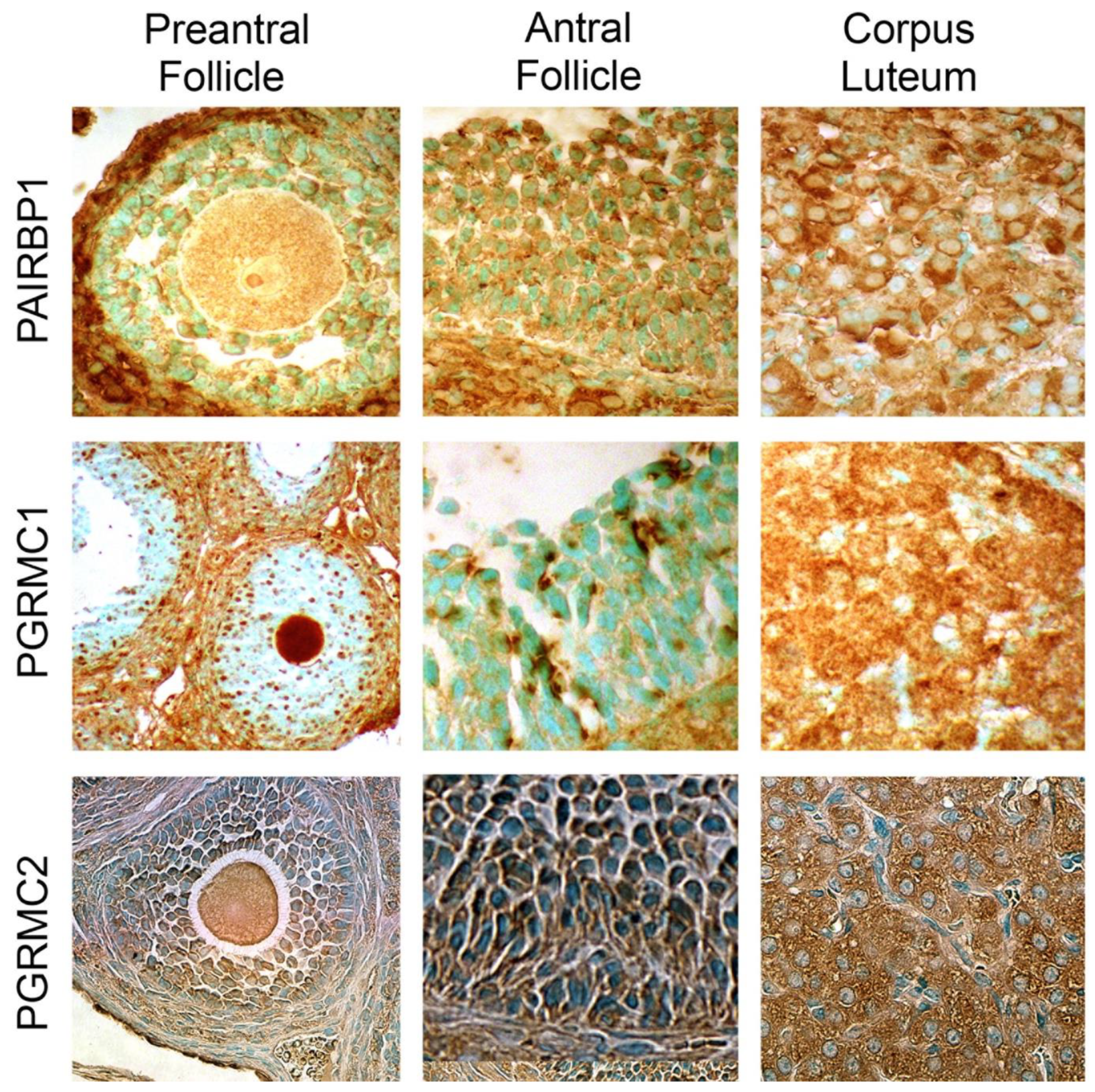
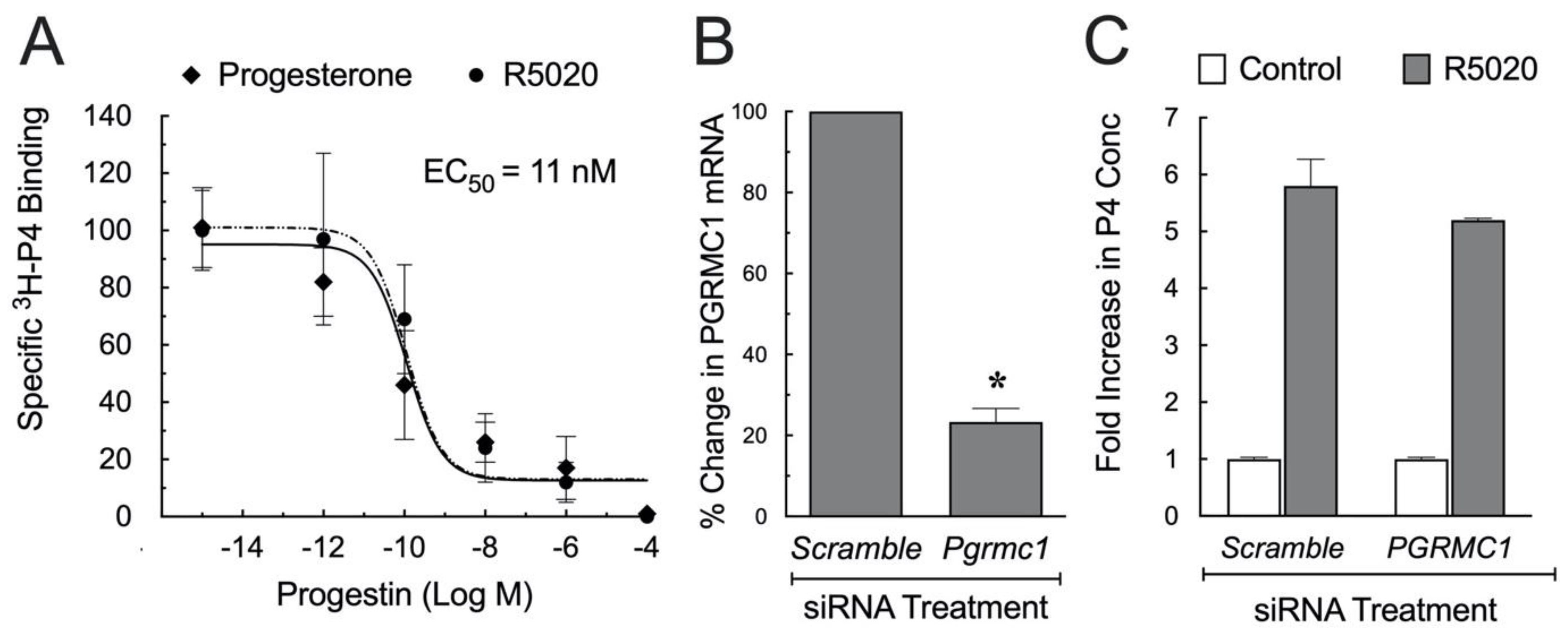

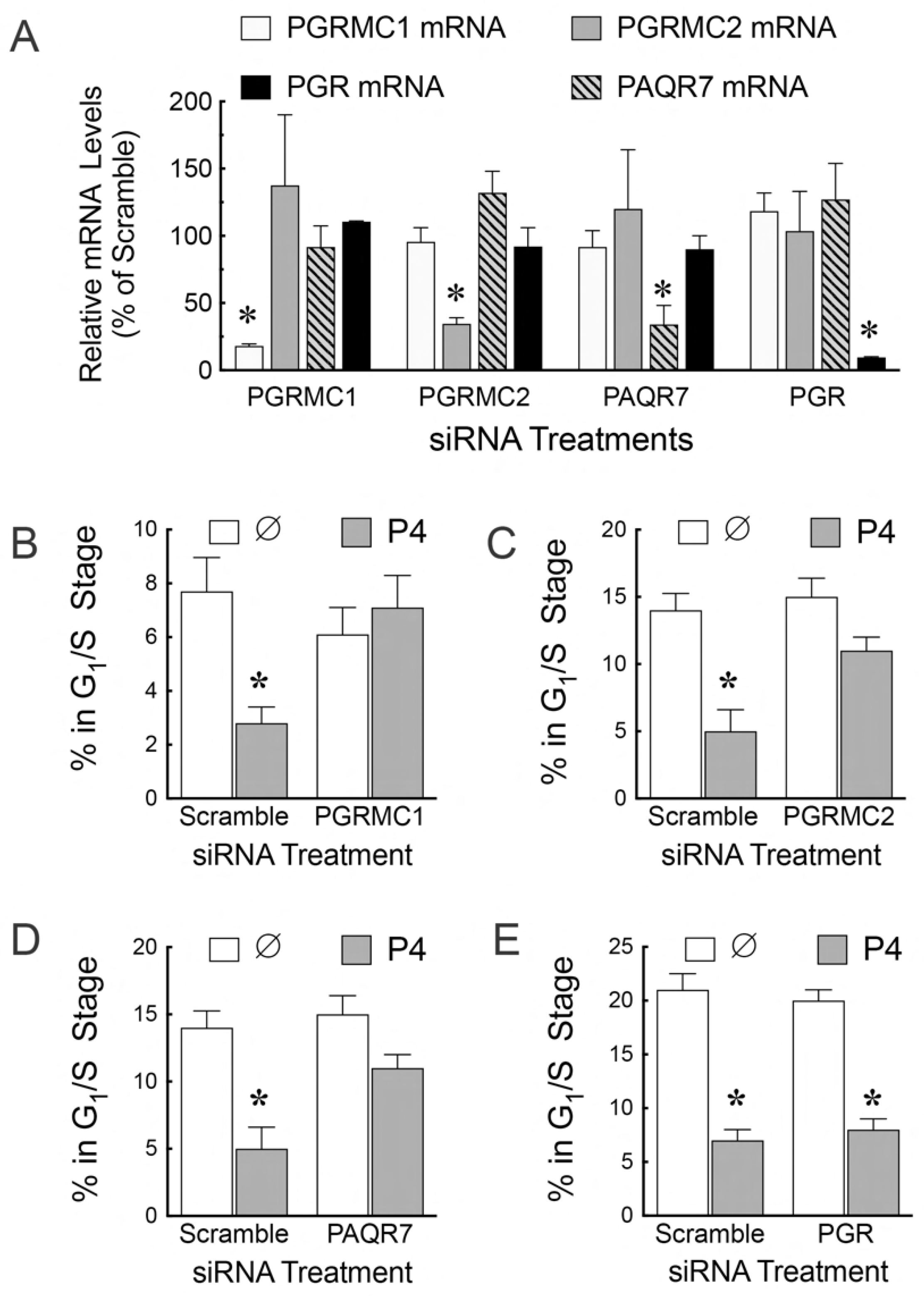

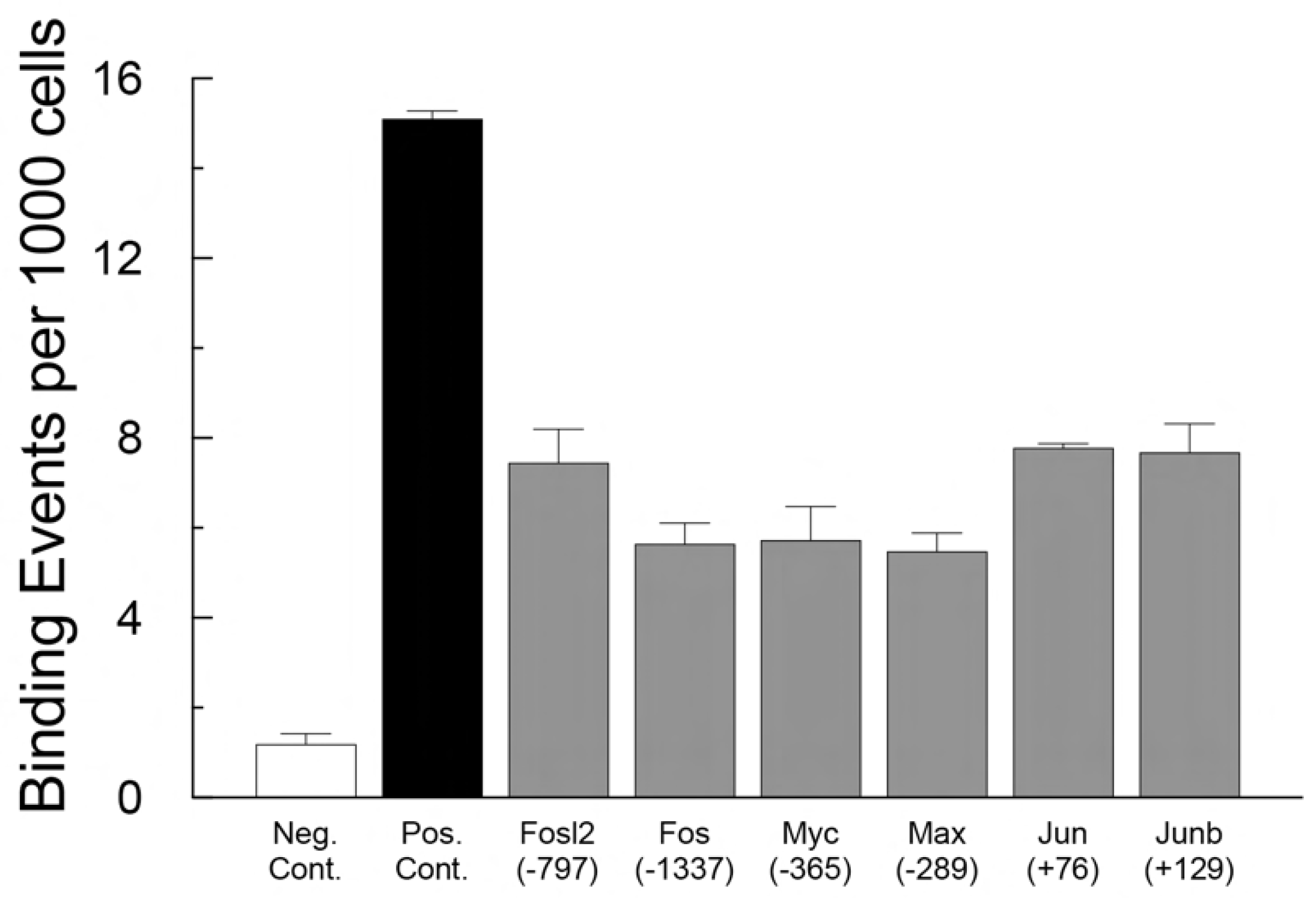
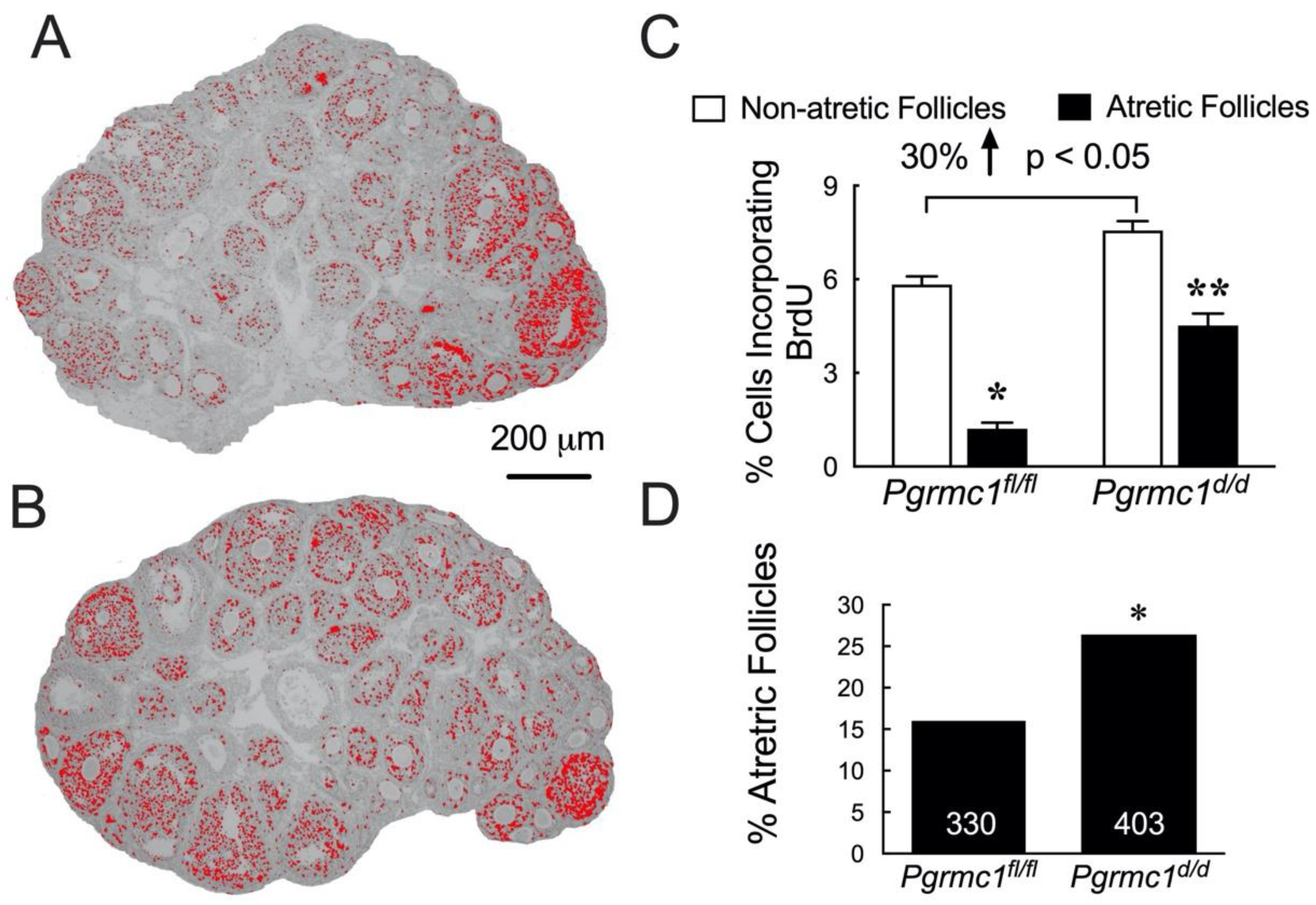
Publisher’s Note: MDPI stays neutral with regard to jurisdictional claims in published maps and institutional affiliations. |
© 2022 by the author. Licensee MDPI, Basel, Switzerland. This article is an open access article distributed under the terms and conditions of the Creative Commons Attribution (CC BY) license (https://creativecommons.org/licenses/by/4.0/).
Share and Cite
Peluso, J.J. Progesterone Signaling and Mammalian Ovarian Follicle Growth Mediated by Progesterone Receptor Membrane Component Family Members. Cells 2022, 11, 1632. https://doi.org/10.3390/cells11101632
Peluso JJ. Progesterone Signaling and Mammalian Ovarian Follicle Growth Mediated by Progesterone Receptor Membrane Component Family Members. Cells. 2022; 11(10):1632. https://doi.org/10.3390/cells11101632
Chicago/Turabian StylePeluso, John J. 2022. "Progesterone Signaling and Mammalian Ovarian Follicle Growth Mediated by Progesterone Receptor Membrane Component Family Members" Cells 11, no. 10: 1632. https://doi.org/10.3390/cells11101632
APA StylePeluso, J. J. (2022). Progesterone Signaling and Mammalian Ovarian Follicle Growth Mediated by Progesterone Receptor Membrane Component Family Members. Cells, 11(10), 1632. https://doi.org/10.3390/cells11101632




